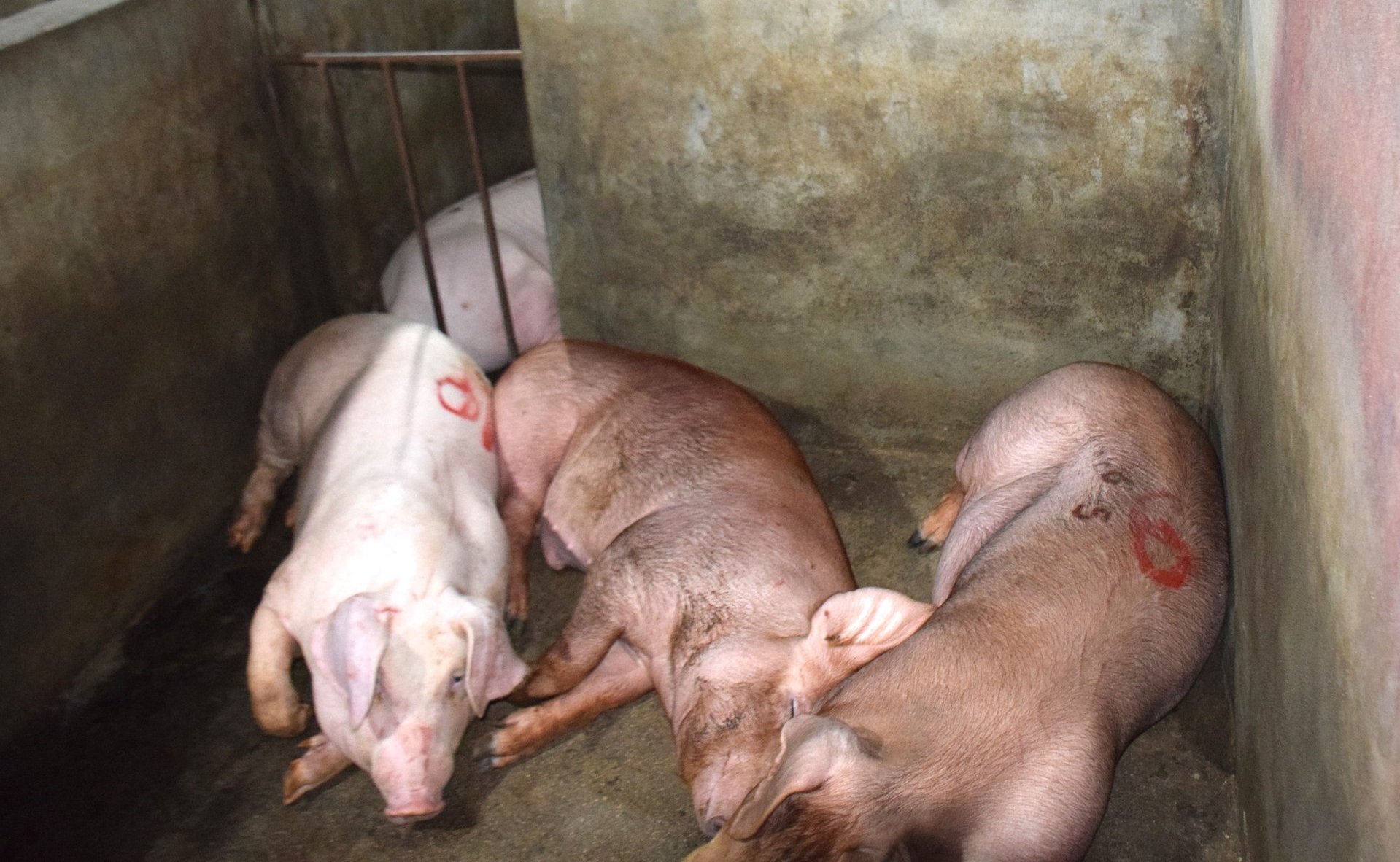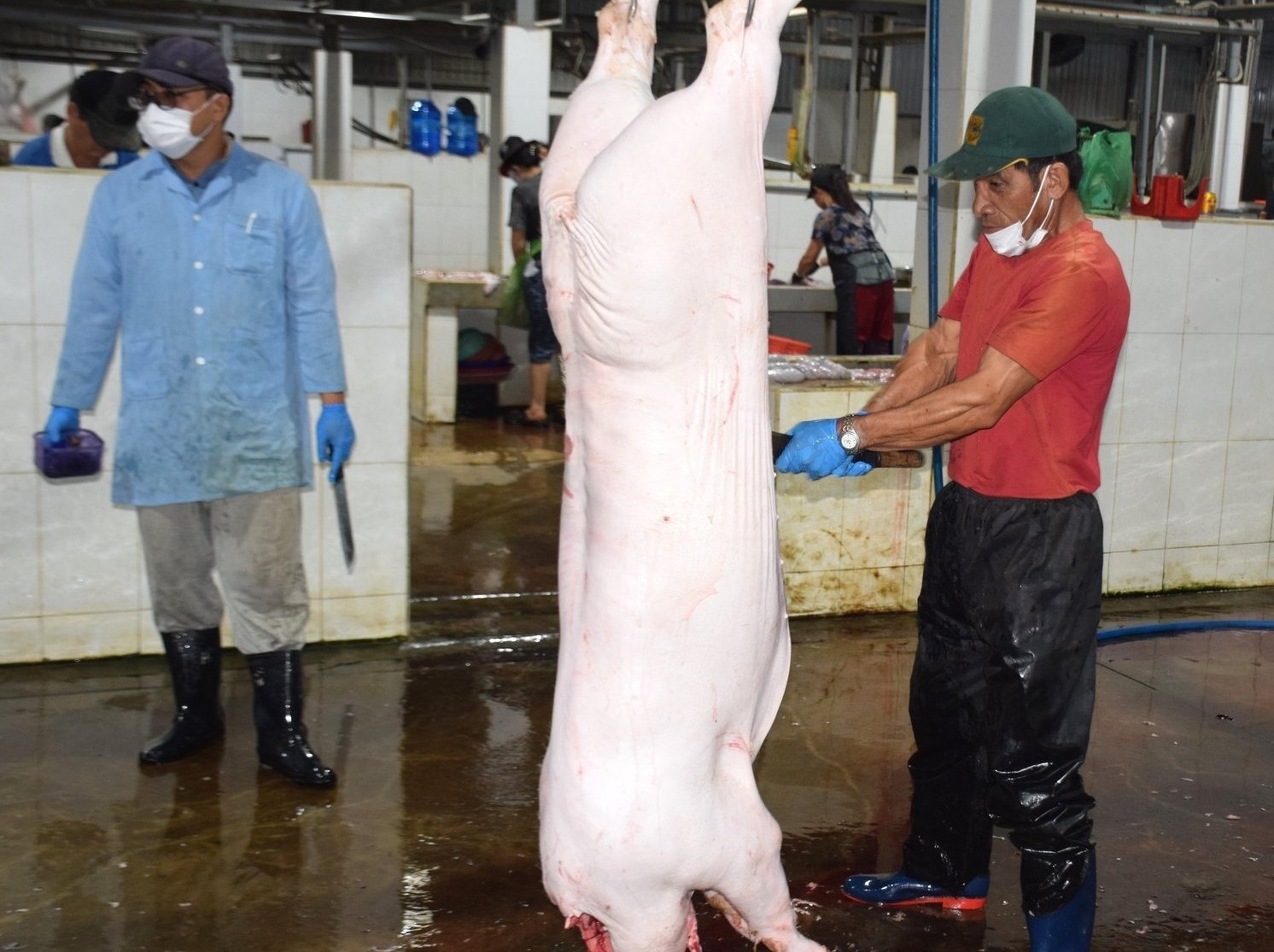December 31, 2025 | 12:36 GMT +7
December 31, 2025 | 12:36 GMT +7
Hotline: 0913.378.918
December 31, 2025 | 12:36 GMT +7
Hotline: 0913.378.918
In the context of complicated weather and African swine fever, not only does Gia Lai province advise farmers to promote livestock care by regularly disinfecting barns and the farming environment, but its authorities also strictly control the input of concentrated animal slaughterhouses in the area. The ultimate goal is to avoid the situation of pigs that have tested positive for the African swine fever virus "leaking" into slaughterhouses, leading to widespread disease.

Pigs are carefully inspected before being put into the facility for slaughter the next morning. Photo: V.D.T.
Following Huynh Van Thanh, a veterinary officer in Gia Lai, we arrive at the An Nhon concentrated animal slaughterhouse located in An Nhon Dong commune at 2 a.m. to learn about the slaughtering process there.
According to Thanh, the slaughterhouse starts working at 2 a.m., but from 9 a.m. the previous morning, the slaughterhouse had opened the gate to receive livestock brought by people. From 9 a.m. to 10 p.m. every day, at the gate of the concentrated animal slaughterhouse, there are always two veterinary officers present to conduct clinical examination and check the origin and health status of pigs brought into the facility.
“Live animal inspection is a clinical examination done by the naked eye or by thermometer, which sometimes leads to errors. For example, if a pig is infected with the African swine fever virus but does not have bleeding on the skin, or does not show signs of fever, the naked eye and thermometer cannot detect it. Even if the infected pig enters a slaughterhouse, the spread of the disease will be limited because the slaughterhouse has applied thorough disease prevention measures,” he said.
In order to have sufficient human resources for assignment at the An Nhon concentrated animal slaughterhouse, the livestock and veterinary sector at the facility must contract with eight veterinary staff who were previously commune or village-level veterinary officers.
As the facility begins slaughtering operations, there are four other veterinary staff on duty to control the slaughter process. The team includes three veterinary staff members on duty at the pig slaughter lines and one staff member at the chicken slaughter line. The remaining two staff are rotated to inspect live animals or control the slaughter activities.
“In case of an epidemic in the area or a large number of animals brought in for slaughter, all eight veterinary staff must be mobilized to work together, divided into specific shifts. During the day shift, four people will check live animals, and at night, four people will monitor and put the slaughter control stamps. The veterinary staff basically have to work continuously without days off, so we take turns by working the day shift today and the night shift tomorrow to preserve our health,” said Thanh.

Veterinary staff in charge of slaughter control at the An Nhon concentrated animal slaughterhouse (Gia Lai) strictly control all stages in the slaughtering process. Photo: V.D.T.
According to Huynh Ngoc Diep from Gia Lai Sub-Department of Livestock Production and Animal Health, in the context of very unusual weather and complicated developments of African swine fever, Gia Lai Sub-Department of Livestock Production and Animal Health directed veterinary staff in localities to strengthen inspection, monitoring, warning, and timely detection of epidemics. Pig farmers are also recommended to fully vaccinate their livestock.
The plain area of Gia Lai province is experiencing extremely hot weather with occasional rains, thus the animals' bodies cannot adjust to the weather in time. When the weather is too hot, the animals suffer a loss of appetite, so their resistance is reduced. African swine fever has appeared in the area before, so the pathogen still exists in the environment. The lowered resistance of the animals is a favorable condition for the pathogen to invade and cause harm.
There are currently three types of African swine fever vaccines allowed to circulate in Vietnam, which are the NAVET-ASFVAC vaccine of the National Veterinary Joint Stock Company (NAVETCO), AVAC ASF LIVE vaccine of AVAC Vietnam Joint Stock Company and Dacovac-ASF2 vaccine of Dabaco Vietnam Group. African swine fever vaccination in Gia Lai is currently being carried out in a socialized manner. Therefore, the Sub-Department of Livestock Production and Animal Health has advised the Provincial People's Committee to encourage farmers to use these vaccines as a way to preserve the pig herd.
“According to the media, using those vaccines against African swine fever shows high efficiency in some localities. The authorities also recommend that before vaccinating against African swine fever, farmers must inform the local veterinary office to receive guidance and choose the right type of vaccine, and when vaccinating, there must be a veterinary officer to make sure whether the vaccine is being administered to the right subjects to avoid unfortunate incidents,” said Huynh Ngoc Diep.
Translated by Samuel Pham

(VAN) From extensive shrimp ponds, baskets of don gathered on the mudflats, to boats carrying visitors to watch birds, all livelihoods here depend on clean water, green forests, and the calls of migratory birds.
/2025/12/26/0703-3-204813_117.jpg)
(VAN) Transparency in information and listening to local people have helped address ground clearance bottlenecks and build social consensus, thereby accelerating the progress of the JICA3 irrigation project.
/2025/12/27/0609-3-233846_327.jpg)
(VAN) The JICA3 project is expected to become a 'water shield,' helping control saltwater intrusion, proactively secure water resources, protect livelihoods, and promote sustainable development in coastal areas.
/2025/12/26/5654-3-164509_655.jpg)
(VAN) As Viet Nam makes strong commitments toward achieving net-zero emissions, controlling and reducing methane emissions in livestock production is increasingly becoming a mandatory requirement.

(VAN) 'People, Primates, Plants: Co-managing Biodiversity and Improving Livelihoods in Vietnam' (the PPP Project) is an international initiative implemented in Vietnam by BGCI, CEGORN, and ICRAF/World Agroforestry.

(VAN) Dak Nong established a risk-level zoning map for coffee, built a digital data platform for the sector, and promoted certified production in line with EUDR.
/2025/12/25/2709-1-211551_295.jpg)
(VAN) In response to the U.S. Marine Mammal Protection Act (MMPA), Gia Lai province is implementing many solutions to protect marine mammals and develop sustainable, responsible fisheries.